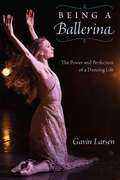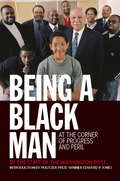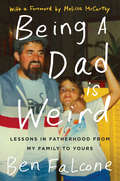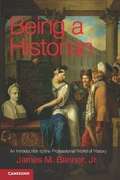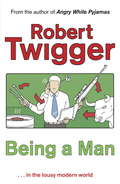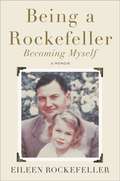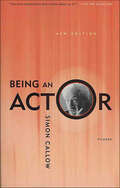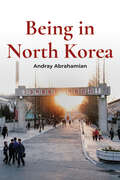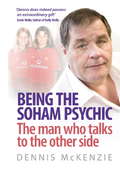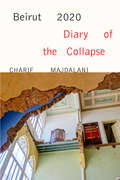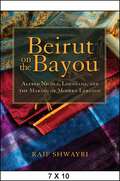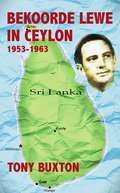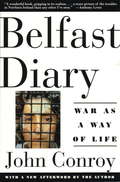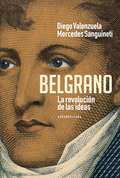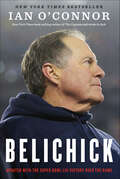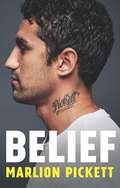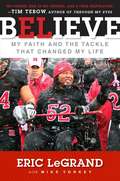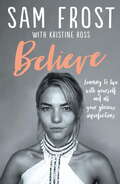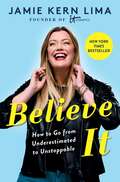- Table View
- List View
Being a Ballerina: The Power and Perfection of a Dancing Life
by Gavin LarsenA look inside a dancer’s world Inspiring, revealing, and deeply relatable, Being a Ballerina is a firsthand look at the realities of life as a professional ballet dancer. Through episodes from her own career, Gavin Larsen describes the forces that drive a person to study dance; the daily balance that dancers navigate between hardship and joy; and the dancer’s continual quest to discover who they are as a person and as an artist. Starting with her arrival as a young beginner at a class too advanced for her, Larsen tells how the embarrassing mistake ended up helping her learn quickly and advance rapidly. In other stories of her early teachers, training, and auditions, she explains how she gradually came to understand and achieve what she and her body were capable of. Larsen then re-creates scenes from her experiences in dance companies, from unglamorous roles to exhilarating performances. Working as a ballerina was shocking and scary at first, she says, recalling unexpected injuries, leaps of faith, and her constant struggle to operate at the level she wanted—but full of enormously rewarding moments. Larsen also reflects candidly on her difficult decision to retire at age 35. An ideal read for aspiring dancers, Larsen’s memoir will also delight experienced dance professionals and fascinate anyone who wonders what it takes to live a life dedicated to the perfection of the art form.
Being a Black Man: At the Corner of Progress and Peril
by Kevin MeridaOver the last 100 years, perhaps no segment of the American population has been more analyzed than black males. The subject of myriad studies and dozens of government boards and commissions, black men have been variously depicted as the progenitors of pop culture and the menaces of society, their individuality often obscured by the narrow images that linger in the public mind. Ten years after the Million Man March, the largest gathering of black men in the nation's history, Washington Post staffers began meeting to discuss what had become of black men in the ensuing decade. How could their progress and failures be measured? Their questions resulted in a Post series which generated enormous public interest and inspired a succession of dynamic public meetings. It included the findings of an ambitious nationwide poll and offered an eye-opening window into questions of race and black male identity-questions gaining increasing attention with the emergence of Senator Barack Obama as a serious presidential contender. At the end of the day, the project revealed that black men are deeply divided over how they view each other and their country. Now collected in one volume with several new essays as well as an introduction by Pulitzer Prizewinning novelist Edward P. Jones, these poignant and provocative articles let us see and hear black men like they've never been seen and heard before.
Being a Dad Is Weird: Lessons in Fatherhood from My Family to Yours
by Ben FalconeThe actor, writer, and director combines amusing stories about his dad with his own experiences raising two daughters with his wife, Melissa McCarthy.Though he’s best known for his appearances in the movie Enough Said, as well as his hilarious role as Air Marshall Jon in Bridesmaids, Ben Falcone isn’t a big shot movie star director at home. There, he’s just dad. In this winning collection of stories, Ben shares his funny and poignant adventures as the husband of Melissa McCarthy, and the father of their two young daughters. He also shares tales from his own childhood in Southern Illinois, and life with his father—an outspoken, brilliant, but unconventional man with a big heart and a somewhat casual approach to employment named Steve Falcone.Ben is just an ordinary dad who has his share of fights with other parents blocking his view with their expensive electronic devices at school performances. Navigating the complicated role of being the only male in a house full of women, he finds himself growing more and more concerned as he sounds more and more like his dad. While Steve Falcone may not have been the briefcase and gray flannel suit type, he taught Ben priceless lessons about what matters most in life. A supportive, creative, and downright funny dad, Steve made sure his sons’ lives were never dull—a sense of adventure that carries through this warm, sometimes hilarious, and poignant memoir.“Containing self-help advice as well as threads of memoir and humor, Ben Falcone’s first book, Being a Dad Is Weird, is an absolute must-read.” —Manhattan Book Review
Being a Historian: An Introduction to the Professional World of History
by James M. Banner Jr.Considers what aspiring and mature historians need to know about the discipline of history in the United States today.
Being a Man
by Robert TwiggerFurther adventures in extreme (and not so extreme) sports, from the bestselling author of ANGRY WHITE PYJAMAS.Having learnt Aikido with the Tokyo riot police (ANGRY WHITE PYJAMAS) and hunted for the world's longest snake in the jungles of the Far East (BIG SNAKE), Robert Twigger now turns his attention to other traditionally male pursuits and pastimes (some of which are fairly close to home, some of which are more extreme), and looks at the questions these raise about masculinity and the role of man in modern society. BEING A MAN features Twigger participating in, and writing on: the informal rules and thrill seeking of solo climbing, bullfighting in Spain, the 'illicit pleasure of buying my first gun', and the rules of survival with a tribe of Naga headhunters - the sort of activities and pursuits often scorned in the modern, interiorised office-based world.
Being a Man
by Robert TwiggerFurther adventures in extreme (and not so extreme) sports, from the bestselling author of ANGRY WHITE PYJAMAS.Having learnt Aikido with the Tokyo riot police (ANGRY WHITE PYJAMAS) and hunted for the world's longest snake in the jungles of the Far East (BIG SNAKE), Robert Twigger now turns his attention to other traditionally male pursuits and pastimes (some of which are fairly close to home, some of which are more extreme), and looks at the questions these raise about masculinity and the role of man in modern society. BEING A MAN features Twigger participating in, and writing on: the informal rules and thrill seeking of solo climbing, bullfighting in Spain, the 'illicit pleasure of buying my first gun', and the rules of survival with a tribe of Naga headhunters - the sort of activities and pursuits often scorned in the modern, interiorised office-based world.
Being a Rockefeller, Becoming Myself: A Memoir
by Eileen RockefellerThe daughter of David and Peggy Rockefeller and a great-granddaughter of John D. Rockefeller, Eileen Rockefeller understood at an early age that her name was synonymous with American royalty. She learned in childhood that wealth and fame could open any door; but as the youngest of six children and one of twenty-two cousins in one of the world's most famous families, she began to realize that they could not buy a sense of personal worth. Growing up with servants in lavish homes did little to compensate for the absence of parental attention resulting from continual cocktail and dinner parties, meetings, and foreign travel. Her mother's dark depressions and mercurial moods, plus intense competition from her siblings, and the myriad feelings others harbored about her Rockefeller name - adulation, judgment, envy, and endless curiosity - contributed to Eileen's sense of isolation and loneliness as well as to her drive for connection with others. In adulthood, she has become not an icon, but an accomplished woman and mother. Like all of us, she learned to find her own way. Through her intimate stories she shows us her philosophy: that power and richness come not from material goods, but from personal relationships and co-creation. This belief has strengthened her dedication to family and friends, and catalyzed her leadership in philanthropy and service. A pioneer in mind/body practices and social and emotional learning, and an active proponent of environmental sustainability, Eileen has forged a singular path even as she remains dedicated to her family's legacy, finding her own balance and peace of mind. Being a Rockefeller, Becoming Myself is a universal affirmation of how identity is shaped and how we can contribute to the larger family of life, regardless of our origins. .
Being an Actor
by Simon CallowA new edition of the classic book for actors starting their careers, with new materialFew actors have ever been more eloquent, more honest, or more entertaining about their life and their profession than Simon Callow, one of the finest actors of his time and increasingly one of the most admired writers about the theater.Beginning with the letter to Laurence Olivier that produced his first theatrical job to his triumph as Mozart in the original production of Amadeus, Callow takes us with him on his progress through England's rich and demanding theater: his training at London's famed Drama Centre, his grim and glorious apprenticeship in the provincial theater, his breakthrough at the Joint Stock Company, and then success at Olivier's National Theatre are among the way stations.Callow provides a guide not only to the actor's profession but also to the intricacies of his art, from unemployment—"the primeval slime from which all actors emerge and to which, inevitably, they return"—to the last night of a long run.
Being in North Korea
by Andray AbrahamianIn 2009, while working on a PhD in Seoul, Andray Abrahamian visited North Korea, a country he had studied for years but never seen. He returned determined to find a way to work closely with North Koreans. Ten years and more than thirty visits later, Being in North Korea tells the story of his experiences setting up and running Choson Exchange, a non-profit that teaches North Koreans about entrepreneurship and economic policy. Abrahamian was provided a unique vantage into life in North Korea that belies stereotypes rampant in the media, instead revealing North Koreans as individuals ranging from true believers in the system to cynics wishing the Stalinist experiment would just end; from introverts to bubbly chatterboxes, optimists to pessimists. He sees a North Korea that is changing, invalidating some assumptions held in the West, but perhaps reinforcing others. Amid his stories of coping with the North Korean system, of the foreigners who frequent Pyongyang, and of everyday relationships, Abrahamian explores the challenges of teaching the inherently political subject of economics in a system where everyone must self-regulate their own minds; he looks at the role of women in the North Korean economy, and their exclusion from leadership; and he discusses how information is restricted, propaganda is distributed and internalized, and even how Pyongyang's nominally illicit property market functions. Along with these stories he interweaves the historical events that have led to today's North Korea. Drawing on the breadth of the author's in-country experience, Being in North Korea combines the intellectual rigor of a scholar with a writing style that will appeal to a general audience. Through the personal elements of a memoir that provide insights into North Korean society, readers will come away with a more realistic picture of the country and its people, and a better idea of what the future may hold for the nation.
Being the Soham Psychic
by Dennis MckenzieThe remarkable story of one man's paranormal powers... 'I am really sorry but both the girls are dead'. Dennis McKenzie was brought to the world's attention following his involvement in the tragic Soham murder case. Making stunningly accurate predictions about the deaths of Holly Wells and Jessica Chapman, he was dubbed the 'Soham Psychic'. Since then, Dennis's expertise has continually been drawn on to help solve many horrific crimes, including the case of the 'BTK' Killer - a serial killer who bound, tortured and killed women in Wichita, Kansas and evaded the police for over 30 years. An ordinary boy from a working-class background, Dennis never imagined his life would follow such an extraordinary path. From his first psychic sighting at the age of four to his traumatic prediction of a family friend's death, Dennis shares the experiences that have defined his remarkable life in his typically frank and down-to-earth way. This is the fascinating story of how Dennis discovered his gift and how, with the help of his spirit guides, he has shared his psychic wisdom with the world.
Being the Soham Psychic
by Dennis MckenzieThe remarkable story of one man's paranormal powers... 'I am really sorry but both the girls are dead'. Dennis McKenzie was brought to the world's attention following his involvement in the tragic Soham murder case. Making stunningly accurate predictions about the deaths of Holly Wells and Jessica Chapman, he was dubbed the 'Soham Psychic'. Since then, Dennis's expertise has continually been drawn on to help solve many horrific crimes, including the case of the 'BTK' Killer - a serial killer who bound, tortured and killed women in Wichita, Kansas and evaded the police for over 30 years. An ordinary boy from a working-class background, Dennis never imagined his life would follow such an extraordinary path. From his first psychic sighting at the age of four to his traumatic prediction of a family friend's death, Dennis shares the experiences that have defined his remarkable life in his typically frank and down-to-earth way. This is the fascinating story of how Dennis discovered his gift and how, with the help of his spirit guides, he has shared his psychic wisdom with the world.
Beirut 2020: Diary of the Collapse
by Charif MajdalaniTold in elegant, evocative prose, a devastating and necessary testament to the August explosion that thoughtfully examines the crises that preceded it and its aftermath.At the start of the summer of 2020, in a Lebanon ruined by economic crisis and political corruption, in an exhausted Beirut still rising up for true democracy while the world was paralyzed by the coronavirus, Charif Majdalani set about writing a journal. He intended to bear witness to this terrible, confusing time, and perhaps endure it by putting it into words. Using small, everyday interactions—with fellow restaurant patrons, repairmen, the father of his wife&’s patient, a young Syrian refugee—as openings to address larger systemic problems, he explains how events in Lebanon&’s recent history led to this point.Then, on August 4, the explosion of 2,750 tons of ammonium nitrate in the port of Beirut devastated the city and the country. Majdalani&’s chronicle suddenly became a record of the catastrophe, which left more than two hundred dead and thousands injured, and the massive public outcry that followed. In the midst of the senseless chaos and grief, however, he continues to find cause for hope in the kindness and resilience of those determined to stay and rebuild.
Beirut 2020: The Collapse of a Civilization, a Journal
by Charif Majdalani'The author's home town is falling apart. Lebanon's capital [...] has morphed into a symbol of devastation and hatred and madness. Majdalani is a survivor who still finds in himself the elegance to smile and hope' Amin Maalouf, Prix Goncourt winner'It is rare to capture the moment when it first occurs, in real time, with these seemingly humble details that describe the instant in all its depth' Alexandra Schwartzbrod, Libération'A short narrative that strikes straight at the heart' Gaëtane Morin, Le ParisienWhen Charif Majdalani begins to walk the streets of his city, and to write down what he sees, the first hints of unrest within a vibrant culture creep to the fore. Majdalani's reportage through the months of 2020 bears witness to the ways in which an ancient civilization slowly, then rapidly, descends into the abyss: corruption and vice infect the corridors of power; currency plummets into freefall, rats scurry between piles of rotting rubbish that grow higher along the pavements. Born from the rancour of existential pestilence, violence erupts and Beirut's citizens find themselves in high-voltage stand-offs with law enforcement.Then, the unexpected, Beirut collapses under the explosive force of 2,750 tons of ammonium nitrate. The blast kills hundreds and injures thousands. But through the rubble and the sirens, a people finds its strength to survive and its heart to unite. The city becomes the metaphor for each of our cultural capitals throughout the world.
Beirut Diary
by Charles L. BreindelThe book recounts Dr. Breindel's professorship in Beirut in 1982, how fighting broke out, and how he and others were daptured. The book shows how the experience changed his life. Really interesting. "This book has been a long time in formulation. It has been an idea gestating in my mind and in those of many dear friends who wanted to hear the story of my third and final trip to the American University of Beirut. It was well known by many that I kept detailed diaries during those early days of international travel. Because of that, many have been requesting the publication of the diary from that fateful trip 23 years ago. But I was not ready to share my story, nor the significance that those days in Beirut in the spring of 1982 had on my life. I was still an "open book," naive and looking for meaning in life, after I got back home. What I found in Beirut was not apparent to me until many years later when good hindsight brought into better perspective the life-changing experience of Beirut. I went to Beirut as a young visiting assistant professor to teach a short course in health planning. I returned still the same professional, but with a different worldview, a budding sense of God in my life, and a new hunger for understanding and wisdom that was unparalleled in my prior life. Before Beirut, I was "putting in time," existing, not being particularly satisfied, yet not dissatisfied. Not knowing the possibilities available in my life, I was unaware that there were other possibilities, other realities."
Beirut on the Bayou: Alfred Nicola, Louisiana, and the Making of Modern Lebanon
by Raif ShwayriRaif Shwayri begins his family's story with his grandfather Habib Shwayri's arrival at Ellis Island in 1902. Having left Beirut, then a harbor city on the Syrian coast of the Ottoman Empire, only weeks before, he took the name Alfred Nicola and made his way to relatives in New Orleans. There, he began peddling down the Bayou Lafourche, befriending the communities living alongside the water and earning the nickname "Sweet Papa" for his kindness and generosity. When he returned home to Lebanon in 1920, he invested the money he had made, from years of peddling, in real estate and died a wealthy man in 1956. After his death, his youngest son, Nadim (Raif's father), turned his part of the inheritance into an endowment that started Al-Kafaàt, an iconic and unique institution in Lebanon that serves the handicapped and underprivileged.Alfred Nicola's story, like the story of Lebanon itself, begins farther back in history. In its account of centuries of Ottoman rule, decades of colonial occupation, and years of internal political strife and civil war, Beirut on the Bayou intertwines a family narrative with the story of a people, of Lebanon in the making. From the Fertile Crescent that was Syria to the Crescent City that is New Orleans, the saga of the Shwayri family reflects the experiences of those Lebanese who walked the path of immigration to the United States, as well as those who stayed behind—or returned—to help forge a nation.
Beirut, I Love You
by Zena El KhalilZena el Khalil, a young Beirut-based female artist, writer, and activist who had an unconventional but worldly upbringing growing up in Lagos, Nigeria and attending art school in New York, returns after 9/11 to her familial home of Beirut and its mountains, beaches, food, music and drugs. Beirut, I Love You, spanning from 1994 to the present day, brings Beirut to life in all its glory and contradictions and is filled with personal anecdotes of Zena's life there: a place where, in spite of the pervasive desire for hope and the resilience of its people, still bears deep scars from the Lebanese Civil War and the Israeli invasion of 2006--a place where plastic surgery and AK 47s live side by side and nightclubs are situated on rooftops in order to avoid car bombs. Yet Zena and her friends, in particular her fellow rebel Maya, refuse to accept the extreme poles of Beirut, the militias and gender restrictions on one side, hedonism and materialism on the other. And although Zena experiences tragedy and loss, her story is a testament to the power of love and friendship, and the beauty of her city and its inhabitants. Written with an honest, profound simplicity, Zena is intoxicated by the country's contradictions--"Lebanon was, and always will be, schizophrenic"--and attempts to come to terms with her role among her friends, family, and city.
Bekoorde Lewe in Ceylon: 1953 - 1963
by Tony BuxtonDie skrywer se fassinerende avonture in die vroeë 50’s, beskryf ‘n avontuurlike lewenswyse waaroor die meeste van ons droom, maar wat vandag onmoontlik sal wees. Gebore in Colombo (Sri Lanka) in 1931. Hy het sy kinderlewe in Engeland deurgebring en het hy na die oorlog teruggekeer na Ceylon om in die familie besigheid te werk wat deur sy oupa begin is. Nie die gewone koloniale tipe waarvan daar verwag was om nie met die plaaslike mense te meng of om na hul klubs te gaan nie, het Tony die teenoorgestelde gedoen teen alle reëls in. Tony het die geselskap van die Ceylonese verkies . Dit het tot gevolg gehad dat hy baie vriende gemaak het insluitende bekende politikuste . Hy het ‘n passie vir onderwater verkenning gekweek in ‘n tyd toe die sport maar nog net begin het, voor daar SCUBA was. Hy het sy werk en loopbaan opgegee om op spiesvisvang, krewe, garnale en krappe te oorleef, akwarium visse te vang en in die woude te jag. Hy het homself as ‘n onderwater toergids gevestig wat bekende en ryk mense gelok het. Deur sy dienste verniet aan te bied het hulle hom terug betaal deur hom na hulle huise in Europa te nooi waar hy ‘n lewe beleef het wat hy nie eers geweet het bestaan nie. Gedurende hierdie reise trou hy met drie van sy vier vroue, twee Skandinawiese modelle en ‘n Italiaanse aktrise, aangetrokke tot sy lewenswyse, maar nie een van hulle kon in Ceylon aanpas nie. Die magtige Minister van Toerisme, ‘n duiker homself, stel Tony aan om onderwater toerisme te bevorder. Hulle word hegte vriende en hy raak betrokke in politike intriges. Selfs met geen geld lewe hy gelukkig deur vis te ruil vir basiese behoeftes. Op en af tussen luukse en gewone leefstyle was hy die eerste person om in die Maldives en suid Indië te duik, waar hy ‘n sensasie veroorsaak. Hierdie is ‘n aangrypende verhaal van nie so lank gelede in ‘n unieke Suid-Oostelike Asiatiese land – Ceylon, voor dit ingesluk was deur politieke onrus,
Bela Bartok: Composition, Concepts, and Autograph Sources (Ernest Bloch Lectures #9)
by László SomfaiThis long-awaited, authoritative account of Bartók's compositional processes stresses the composer's position as one of the masters of Western music history and avoids a purely theoretical approach or one that emphasizes him as an enthusiast for Hungarian folk music.For Bèla Bartók, composition often began with improvisation at the piano. Làszló Somfai maintains that Bartók composed without preconceived musical theories and refused to teach composition precisely for this reason. He was not an analytical composer but a musical creator for whom intuition played a central role.These conclusions are the result of Somfai's three decades of work with Bartók's oeuvre; of careful analysis of some 3,600 pages of sketches, drafts, and autograph manuscripts; and of the study of documents reflecting the development of Bartók's compositions. Included as well are corrections preserved only on recordings of Bartók's performances of his own works. Somfai also provides the first comprehensive catalog of every known work of Bartók, published and unpublished, and of all extant draft, sketch, and preparatory material. His book will be basic to all future scholarly work on Bartók and will assist performers in clarifying the problems of Bartók notation. Moreover, it will be a model for future work on other major composers.
Belfast Diary
by John ConroyResolution of intractable problems around the world requires understanding ordinary people as well as leaders. This street-level view of Northern Ireland provides the best explanation of the twenty-five-year conflict.
Belgrano: La revolución de las ideas
by Diego Valenzuela Mercedes SanguinetiEn Belgrano. La rebelión de las ideas, Diego Valenzuela y MercedesSanguinetti sacan a la luz las facetas menos visibles de este prócer denuestra historia. Una biografía completa y única que muestra las facetasque quedaron escondidas debajo de los bronces militares. Manuel Belgrano fue un rebelde. Un hombre que se animó a tomar riesgos.Su vida transcurrió a caballo del viejo orden colonial y la Revoluciónque dio origen a la Nación argentina. Joven privilegiado, se formó enEuropa, donde se nutrió de las nuevas corrientes de pensamiento. Devuelta en Buenos Aires, buscó ponerlas en práctica para derribar losvicios del sistema colonial, entre ellos el contrabando y el monopolio.Su misión fue incentivar el progreso a través de la educación libre ygratuita, el fomento a la agricultura y el comercio.Este libro deja salir a la luz al Belgrano de las ideas, oculto detrásde los bronces militares. Al periodista, al economista, al funcionariotransgresor y al intelectual revolucionario. Sin dejar de revelar susclaroscuros, como la travesura de conseguir el título de abogado con uncertificado falso, o la creación misma de la bandera #a la que mostró enRosario sin el respaldo de las autoridades#.Diego Valenzuela y Mercedes Sanguineti, jóvenes historiadores quelograron el éxito con Sarmiento periodista, reconstruyen la intensa vidade este hombre que murió en la pobreza, aquejado por la enfermedad, lasdeudas y la falta de reconocimiento. Un hombre que renunció a lascomodidades económicas, también a su destino como intelectual, paraexpandir y afianzar la revolución en gran parte del territorioargentino. En definitiva, Belgrano, el de carne y hueso, que merecenuevas miradas y reflexiones como las que ofrece esta biografía. Ellector comprenderá los motivos de la trascendencia de Belgrano y poderrendirle un justo homenaje.
Belichick: The Making Of The Greatest Football Coach Of All Time
by Ian O'ConnorThe definitive, New York Times–bestselling biography of the NFL’s most enigmatic, controversial, and yet successful coach.“With deep reporting and a profound understanding of the football life, Ian O'Connor comes as close as humanly possible to solving the mystery of the great football sphinx . . . and his unmatched coaching career.” —David Maraniss, bestselling author of When Pride Still Mattered, A Life of Vince Lombardi Bill Belichick is perhaps the most fascinating figure in the NFL—the infamously dour face of one of the winningest franchises in sports. As head coach of the New England Patriots, he’s led the team to six Super Bowl championship trophies. In this revelatory and robust biography, readers will come to understand and see Belichick’s full life in football, from watching college games as a kid with his father, a Naval Academy scout, to orchestrating two Super Bowl–winning game plans as defensive coordinator for the Giants, to his dramatic leap to New England, where he has made history.Award-winning columnist and New York Times–bestselling author Ian O’Connor delves into the mind of the man who has earned a place among coaching legends like Lombardi, Halas, and Paul Brown, presenting sides of Belichick that have been previously unexplored. O’Connor discovers how this legendary coach shaped the people he met and worked with in ways perhaps even Belichick himself doesn’t know. Those who follow and love pro football know Bill Belichick only as the hooded genius of the Patriots. But there is so much more—from the hidden tensions and deep layers to his relationship with Tom Brady to his sometimes-frosty dealings with owner Robert Kraft to his ability to earn the unmitigated respect of his players—if not their affection. This is a man who has many facets and, ultimately, has created a notorious football dynasty. Based on exhaustive research and countless interviews, this book circles Belichick to tell his full story for the first time and presents an incisive portrait of a mastermind at work.“A fascinating look inside the team so many of us love to hate.” —Washington Post“This is the kind of gold-standard reporting that all journalists aspire to, and few actually achieve.” —Mike Vaccaro, award-winning columnist, New York Post
Belief
by Dave Warner Marlion PickettFrom prison to premiership glory; this is Marlion Pickett&’s extraordinary story. It&’s the third quarter in the biggest game of the season. A young man lines up for goal. The 100,000 strong crowd leaps to its feet and roars as Marlion Pickett sends the ball soaring through the goalposts for his first ever major, celebrated by every teammate, a tradition upheld even on Grand Final day.It was the 2019 AFL Grand Final, and Richmond&’s Marlion Pickett was making history as the first player in over 50 years to debut on that &‘one day in September&’.Marlion helped the Tigers thrash the Greater Western Sydney Giants in their debut grand final appearance and was judged third best on ground, only six days after steering Richmond&’s VFL team with his best on ground performance to their nail biting Grand Final victory.Marlion Pickett&’s extraordinary story of redemption is a true fairy tale. The tale of a man who came back from the brink to triumph on Australian sport&’s biggest stage, a long-held dream come true.What&’s even more remarkable about Marlion&’s journey is how this young, troubled Aboriginal kid from Western Australia ever got his chance in the first place. A story all too sadly familiar – about drugs, crime, violence and time spent in jail – but also about a life picked up piece by piece through his own belief in himself and those around him who believed in him too.Belief also takes us inside the South Fremantle and Richmond Football clubs – clubs that have made stars and cult heroes out of other Indigenous players; clubs willing to overlook a talented kid&’s troubled past to give him a chance. We meet the fellow players and support network who stood by Marlion&’s side as he fought back against injury and the doubters and proudly ran onto the field at the MCG.Marlion&’s resilience and strength is inspirational. His is an unforgettable Australian story of triumph over adversity.
Believe
by Eric LegrandBelieve is the profoundly moving story of Eric LeGrand, the former defensive tackle for the Rutgers University Scarlet Knights football team, who suffered a severe spinal cord injury and was left paralyzed by a crushing on-field tackle during a heated game with Army. A remarkable true account of a courageous young athlete whose unshakable faith, spirit, positive outlook, and rousing motto, “BELIEVE!” would serve as inspiration to legions of fans—and as motivation in his own quest to walk again—Eric’s story has received national attention, heavily covered by ESPN and Sports Illustrated.
Believe
by Sam FrostI don't claim to know all the answers; most of the time I'm still figuring it out myself. But what I can do is share an insight into the challenges I've faced from depression, anxiety, social media, toxic relationships, body image issues, and grief. I can offer you tips that have helped me find the light when darkness is all that I could see.When Sam Frost first came to the nation's attention after winning the second season of The Bachelor, it was as though her life was a fairytale. Then a down-to-earth 25-year-old who wore her heart on her sleeve, she captivated Australians far and wide. When that chapter of her life ended, it left Sam heartbroken and facing a public battle with depression and anxiety - but the support she received from people who reached out to detail their own struggles encouraged her to take back control of her story. Since then Sam has kept her connection with the public by being her authentic self - often raw and vulnerable, never hiding behind an illusion of perfection - and always trying to be the best person she can be. She pushed herself to take on a high-profile radio gig and then became an actor. In 2020, with her sister, Kristine, Sam launched BELIEVE by Sam Frost, an online community focusing on mental health, where everyone is included and imperfection is celebrated. In Believe, Sam shares her own experiences navigating dark mental health periods and, alongside Kristine's own insights, offers warm, gentle inspiration and tips to help you come through to the other side of your own. Believe is a personal story, a battle cry and a reassurance for the many of Sam's fans who have struggled as she has.Life isn't perfect, but we can try each day to make it beautiful, and Sam, Kristine and Believe will be your companions through it all.I've had my fair share of battles, and I still believe in the good in the world. I still have faith. I believe that I'm on a journey of self-discovery, of growth and evolution, and I want you to come on the journey with me. Hopefully my story will help you believe in all the beauty life has to offer.
Believe IT: How to Go from Underestimated to Unstoppable
by Jamie Kern Lima#1 WALL STREET JOURNAL BESTSELLER • NEW YORK TIMES BESTSELLER • USA TODAY BESTSELLER ARE YOU READY TO BELIEVE IN YOU? &“Game-changing. Authentic. A must-read for every woman! Jamie is the real deal—and that&’s rare.&” —Glennon Doyle, #1 New York Times bestselling author of Untamed &“Raw. Real. Powerful. Filled with vulnerability and grit. This book will inspire you to believe in your own power. It&’s a book every woman needs!&” —Sara Blakely, Founder SpanxImagine overcoming the things holding you back, breaking through the barrier of self-doubt and fully becoming the person YOU were BORN TO BE! In Believe IT, Jamie Kern Lima, founder of IT Cosmetics, shares the wild but true story of how a once struggling waitress turned her against-the-grain idea into an international bestselling sensation, eventually selling the company for over a billion dollars and becoming the first female CEO of a brand in L&’Oréal&’s 100+ year history. Faced with self-doubt, body-doubt, God-doubt, down to her last few dollars and told &“No one is going to buy makeup from someone who has your body,&” Jamie reveals for the first time what really went down, how she almost didn&’t make it, how she learned to trust herself, and the powerful lessons you, too, can use to go from underestimated to unstoppable. With radical vulnerability and honesty, Jamie takes you on a journey through deeply personal stories of heartbreak and resilience—including accidentally finding out she was adopted when she was in her twenties and the reverberations this has had on all aspects of her life. Jamie also pulls back the curtain on her fight to change the beauty industry&’s use of unrealistic images, on behalf of all the little girls who are about to start doubting themselves, and all of the grown women who still do. Spellbinding, riveting, with raw vulnerability and down-to-earth warmth, Believe IT shakes your soul and shows you that you, too, have what it takes to believe in yourself, trust yourself, and go from doubting you&’re enough to knowing you&’re enough! Do you have big goals, hopes, and dreams but let rejection get in the way? Do you struggle with feeling like you&’re not enough and like success is something that happens to other people, but have a hard time believing it&’s possible for you? Do you let past mistakes and failures hold you back? Do you know deep down inside that you were created for more, but somehow still doubt yourself? In Believe IT you&’ll discover how to... -Overcome self-doubt -Gain the courage to take risks, an empower yourself and others -Tune into and trust your own intuition -Let go of your mistakes and insecurities -Turn down the volume on your inner critic -Handle the rejection, the haters, and the mean girls -Boost your confidence -Start your dream (and keep going!) -And much more… If you&’ve ever doubted yourself or felt truly underestimated, this book will inspire a new kind of belief and confidence in you and your dreams!
